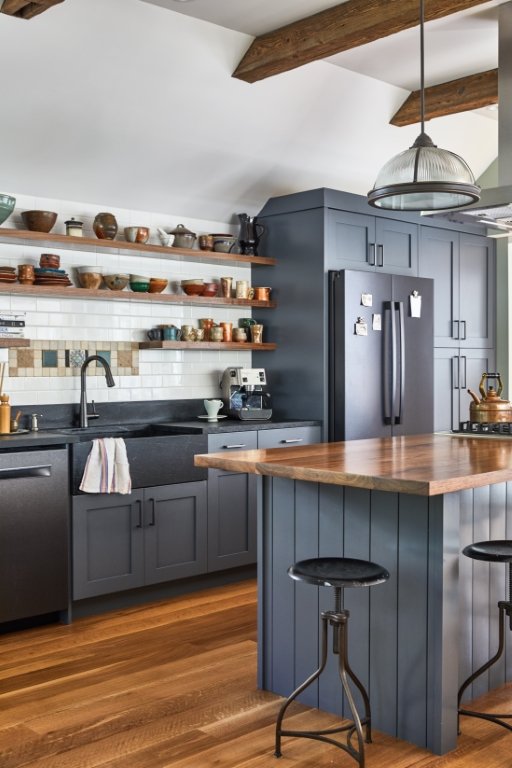Beyond aesthetics: Choosing interiors for sustainability and health
This right-sized Portland kitchen features a timeless design with open shelving that beautifully showcases the owners’ vintage cookware collection. Wood shelving is renewable and simple, with less processing and leaner transportation requirements. BUILDER: HALCYON BUILT, DESIGNER: BALANCE DESIGN STUDIO, PHOTO: ERIN LITTLE
By June Donenfeld
STROLL DOWN THE CEREAL AISLE of any large U.S. supermarket and you’ll see a dizzying array of shapes, colors, flavors and add-ins. Circles, flakes, squares; vanilla, chocolate, strawberry; raisins, berries and marshmallows. And if you look hard, you can even find that rarity: sugar-free, organic and with traceable ingredients.
What does this have to do with choosing a sofa, or coffee table or kitchen cabinets? Bear with me here, because there are strong parallels with the home furnishings and fixtures markets: an almost overwhelming number of shapes, sizes and colors all vying for your attention—and your dollars. But unlike cereals with their nutrition labels, most home furnishings don’t come with easily accessible information that helps conscious consumers make judicious choices. So, without some serious digging, it can be head splittingly hard to choose products that are good for our health, good for the planet and good for communities, from the workers who make home furnishing to the local economies that small businesses support. But don’t let perfection be the enemy of the good. Everyone’s situation is different, so forge ahead with yours in mind, knowing that there will likely be tradeoffs to your decisions—and that’s just fine.
Natural wood features strongly in this Brunswick kitchen, with project design by Maines Design, kitchen design by balance design studio and constructed by Benjamin & Co. It features cabinets from Woodland Cabinetry, an employee-owned, American made brand committed to sustainable materials and practices. PHOTO: ERIN LITTLE.
To help you make these decisions, we talked to two Maine interior designers specializing in sustainability and gathered resources that will enable you to do your own research, too. Catherine Weiland is the founder and principal of balance design studio in Portland, where she designs kitchens with a focus on sustainability, biophilia and timeless style. Jan Robinson is the founder and owner of Portland-based, sustainability-centered design firm, Jan Robinson Interiors, which was also the name of the brick-and-mortar store she ran there from 2012 to 2018.
Refurbish and buy lasting pieces
Before you even start exploring your buying options, Weiland recommends holding off on purchases when you can and “cultivating a sense of contentment with what you already have, which will eliminate the angst of decision-making altogether.” This is where refurbishing can play a role, from painting dated kitchen cabinets to adding new covers for your throw pillows.
When it does come time to buy something, do it with the mindset that you’ll keep it for a long time, an approach that runs counter to our current disposable culture. “I still hear people say it doesn’t matter if that sofa they bought online (or wherever) doesn’t last long, they will get sick of it anyway and will just replace it in three or four years,” Robinson observes. “That [mentality] is why our landfills are overflowing. On average there are over 12 million tons of furniture that end up [there] each year.”
reduce your exposure to vocs
Health considerations may also be something to bear in mind, such as the adverse effects of off-gassing from the materials and finishes in many home furnishings. This process is the release of volatile organic chemicals (VOCs) into the air from a range of sources, such as adhesives in particle board or carpet backing. While these emissions are strongest in new items, Robinson notes that “everything off-gasses to some degree over the life of a product, [though] the amount of VOCs emitted does diminish greatly over time. And some people are more sensitive to off-gassing than others,” including those with respiratory issues or compromised immune systems.
Toxic chemicals also exist in the flame retardants found in many home furnishings, particularly in upholstery in older furniture that pre-dates today’s updated regulations on these potentially poisonous substances. A 2021 study by researchers at the Environmental Working Group (EWG), Silent Spring Institute, Green Science Policy Institute, University of California at Davis and the California Department of Toxic Substances Control showed that replacing a couch, or even replacing the old foam in upholstered furniture with new, toxin-free material, decreases the levels of flame-retardant chemicals in household dust. “Flame retardants migrate from products to air, house dust and the outdoor environment. You can inhale or ingest them or absorb them through your skin,” EWG notes.
The first versions of these chemicals were banned after extensive testing proved their toxicity, but newer versions have not, so it’s still “buyer beware”: According to EWG, “Exposure to flame retardant chemicals has been linked to serious health issues, including cancer, neurotoxicity, thyroid disease and decreased fertility, as well as deficits in motor skills, attention and IQ in children.” In addition to upholstered furniture, old and new, flame retardants can be found in kitchen appliances, carpet padding and foam baby items.
Choose sustainable and locally made furnishings
If the environmental impact of petroleum products is a priority, try to avoid plastics or synthetic fibers such as nylon or polyester. And if you can, both designers advise, buy local. “The amount of energy/fuel required to send a ship full of containers to the States and then truck them across the country is [shocking],” Robinson says, adding home furnishings “are often coming from countries that have no laws that limit toxic materials used or protect the labor force from dangerous working conditions.”
This may all sound doom-and-gloom, but both Weiland and Robinson feel there are certainly encouraging developments. “The good news,” Weiland says, “is that more and better wares are becoming available every day. The best place to start is Maine-made furniture. And if the piece requires textiles for comfort, like cushions or pillows, vet them for chemicals. Or choosing simple furniture designs that allow you to add your own sourced textiles can also be a great option.” To investigate textiles, whether they come with furniture, or you buy them separately, look into any certifications they may have (see sidebar) and look for tip-off terminology like “stain-resistant,” which indicates that a chemical coating has been added to the fabric.
Can’t find what you want locally? “If you have specific concerns about buying furniture that is in some way eco-friendly, there are many good manufacturers out there,” Robinson says. “Most of these companies have websites that will have a sustainability statement, and if you visit the Sustainable Furnishings Council’s website, they will have a list of manufacturers and more information as well.”
Like so much in life, progress in the home furnishings industry is not linear, but there are some strong indicators that things are headed in the right direction, from a growing awareness of the human and environmental toll it exacts to an increase in the number of organizations and businesses working for positive change, from certifying bodies to B Corporations.
To take just one concrete (if imperfect) example of industry change, “Most of the foam made in the U.S.A. now is at least 30% plant based,” Robinson says, “and [manufacturers] are finding ways to reduce the amount of toxins in the foam. Most states are also legislating a maximum level of VOCs, and they are starting to require manufacturers to disclose any toxic materials, such as PFAS, in the product. Maine and California were the first to do so, and there is federal legislation in the works to make it nationwide.” Overall, she feels, “There is more interest on the part of manufacturers to operate more sustainably and use better, safer materials. There are more fabrics available that no longer have some of the worst chemicals added to them. More companies are using fewer toxic adhesives and finishes. But I think we have a very long way to go as a culture and as an industry.”
Consumers have a vital role to play in this progress too, by educating themselves, spending wisely and making their voices heard. And they have another important tool, according to Weiland: optimism. “Approaching the complexity of our era with optimism may seem unrelated to environmentalism,” she says, “But our mindset is vitally important for manifesting a better outcome.” She firmly believes the best option is to be aware and apply three basic principles: “Strive to buy less. When you do buy, consider the impact on community and habitat. Meet uncertainty with (rational) optimism. This will cut out a lot of anxiety-provoking complexity.”
You may always be of two (or more) minds over your home furnishings decisions, but you can still make choices that effect change, however inconsequential they may seem. “My husband and I still debate whether a plastic dish brush is better than a wooden one,” Weiland says. “And that’s OK.”
The furnishings from Rowe Furniture in this Kennebunkport home feature OEKO-TEX certified textiles, 30% plant-based material foam for cushions, recycled metal in the framing support system, and low VOC adhesives. The hanging light fixture was made in Vermont and the rug is 100% wool. INTERIOR DESIGN: JAN ROBINSON INTERIORS, PHOTO: HEIDI KIRN
What can you do to reduce your exposure to toxins at home?
The Environmental Working Group (EWG) recommends the following:
Buy products without flame retardants (check furniture labels).
Don’t reupholster furniture or change carpeting yourself.
Replace cushions with flame-retardant-free ones.
Get rid of damaged cushioning.
Vacuum using a HEPA filter and wet-mop surfaces.
Maine-made home furnishings
Choose locally made furnishings for a lower environmental impact. For a list of Maine artisans crafting home textiles, check out our article “Uncommon Thread: Fresh home textiles from Maine.”
Maine Bunk Beds (mattresses & other furnishings)
Maine Made (state program building recognition for Maine products, producers and industries)
Health and sustainability Certifications
Look for these certifications to identify products and businesses that meet certain standards for health and sustainability.
Oeko-Tex® Standard (textiles)
GOTS: Global Organic Textile Standard (textiles)
CertiPUR-US® (home furnishings foam)
GOLS: Global Organic Latex Standard (organic latex)
C2C: Cradle-to-Cradle Certified (standard focusing on health, equity and sustainability)
B Corporations / B Lab (use “furniture” or “textiles” to help you search)
MEBL (furniture)
This article appeared in the Fall 2024 edition of Green & Healthy Maine HOMES. Subscribe today!
Find Maine experts that specialize in healthy, efficient homes in the Green Homes Business Directory.




